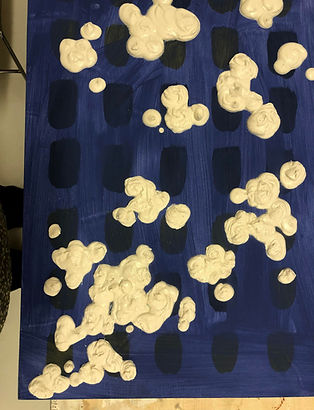Weeks:
Studio Documentation
Week 9 (22nd- 26th Nov)
Painting with Plaster - Large Canvas

I found this wooden canvas that would be thrown away, and I decided to reuse it. I started by painting a base colour, so the work from underneath was barely visible.
I picked a colour that I haven't used before with the other pieces for the base colour.



When the paint was dry, I added plaster, dropping it using an art knife and letting it drip to form mounds. I didn't plan the plaster placement, and I placed it at random, making sure there were areas forming clusters.


I layer the plaster mounds, and I wait for each layer before adding more plaster, ensuring that the plaster can get fully dry. You can see the different levels from looking onto the side from the pictures.
Similar to the canvas, plaster doesn't stick on to the wood. I used PVA adhesive to stick the plaster back to where I placed it when dry. The PVA adhesive allows the piece to be hung without anything falling off.

I was doing the same technique of squeezing the paint directly onto the canvas without mixing. I decided to go with the colour scheme that I naturally use: red, blue, and yellow. I squeezed around an equal amount of each colour of red, yellow and white. I put paint on the areas that looked empty and could be enough space for a broad brush to go through.





This is the outcome. I painted the plaster mounds with excess paint from the canvas dragged by a flat brush. I like the result of this piece. I was right in painting on a larger canvas, showing the painting in motion. The pathways of the paint trail are much longer, so it's very effective when you step up to see the piece as a whole.
I wanted to add something to the background. I felt that it needed something to tie the whole piece together without being overly complicated that it overpowers the plaster and colour swirls, and I wanted to keep those as the main subject of the piece.





I painted the background three shades of blue. The original blue in the background is the darkest, adding two lighter blues to each layer. I gave each blue outline, and I was leaving space of the blue underneath to be seen.
I like this outcome. I think it works in colour and composition, and it's pleasing to the eye and shows movement within the piece. I enjoyed getting to the end of this experiment as it wasn't planned, and I created an outcome due to the experimentation from week 1.
The technique I used to apply the swirls in the paint was interesting. It gives more motion in the swirls as some of the paint isn't mixed properly. You get areas where you see yellow and white. I still felt that the pathways going through the plaster needed to flow naturally, not to look forced. I searched by acrylic fluid painting, thinking it would work well in another large experiment.